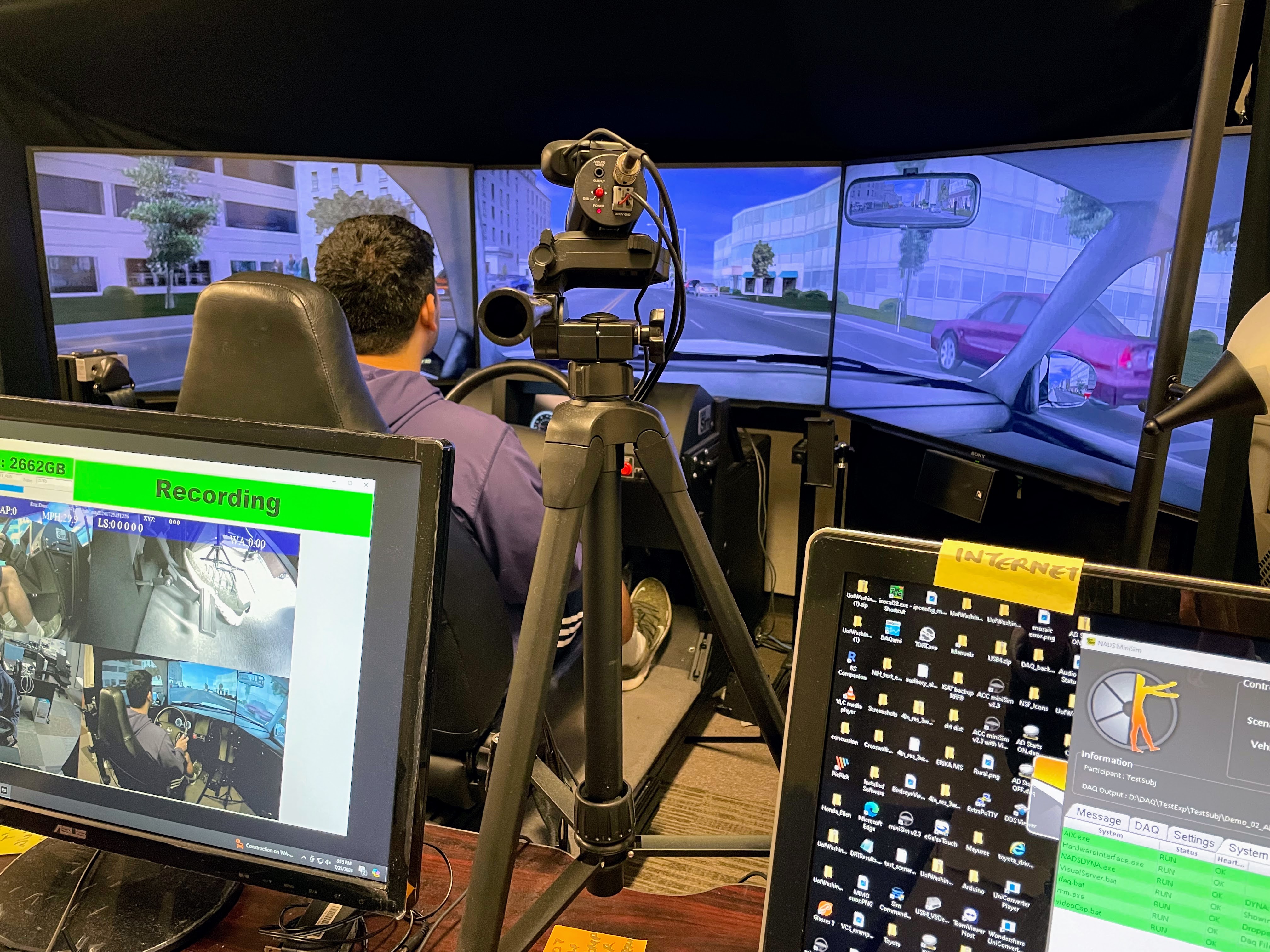Amy Sprague
October 18, 2024
ISE's David Prendez uses advanced simulators to study how people interact with autonomous vehicles, making them safer for everyone.

David Prendez demonstrates how the car simulator works in the Human Factors and Statistical Modeling Lab.
We've all been there: sitting at a green light behind a car that doesn't budge, or trailing a driver who's creeping along at a snail's pace, disrupting the flow of traffic. The culprit? More often than not, it's someone glued to their phone, oblivious to the world around them.

ISE PhD student David Prendez
ISE PhD student David Prendez is working to not only eliminate these scenarios, but replace them with something far more promising. Through his human factors research in autonomous vehicle (AV) technology at ISE's Human Factors and Statistical Modeling Lab, Prendez is paving the way for a safer, more efficient era of transportation that could transform our daily journeys.
At the heart of Prendez's research is a state-of-the-art car simulator that serves as a window into the future of transportation. This advanced tool allows Prendez to investigate how humans interact with autonomous systems in a controlled, risk-free environment.
"This simulator is crucial for pushing the boundaries of autonomous vehicle technology and understanding human-machine interactions," Prendez explains. "It's where we can explore complex scenarios and gather invaluable data without putting anyone at risk."
As an ISE undergraduate, Prendez worked as a research assistant, helping the then-PhD students recruit participants and collect data. Now, he leads research on human-AV interaction and safety, funded under the National Science Foundation's Future of Work program.
"It's been remarkable to see David's evolution from an undergraduate recruiting participants for studies, to now creating his own innovative research," says Linda Ng Boyle, ISE Professor Emeritus and now Vice Dean for Research at New York University's Tandon School of Engineering, and Prendez's principal faculty adviser.
Using the miniSim driving simulator developed by the University of Iowa's Driving Safety Research Institute, Prendez investigates how drivers interact with advanced autonomous systems. "What fascinates me most is seeing how participants interact with the system we've designed," he explains. "Observing their reactions in real-time and analyzing the data provides invaluable insights into human-AV relationships."
One of Prendez's ongoing projects examines how drivers manage their attention during virtual meetings in partially-automated vehicles. As remote work becomes more prevalent and vehicle automation advances, this research addresses a potential near-future scenario where drivers may attempt to multitask during their commute.
The study utilizes a fixed-base driving simulator to recreate a "Level 3" automated driving system, where drivers can fully disengage from the driving task for short periods of time. Participants engage in simulated virtual meetings then face a critical driving moment when they must take control of the vehicle during the meeting (also known as a takeover).
Initial findings reveal a complex interplay between meeting participation and takeover performance in autonomous vehicles. Interestingly, drivers given more time to resume control showed reduced meeting engagement. This decrease in meeting attention is actually beneficial, as it allows drivers to redirect their focus towards the impending traffic event. The research underscores the delicate balance between managing safety-critical situations in automated vehicles and maintaining productivity during virtual meetings.
In another project, Prendez collaborates on developing a framework for real-time detection of driver distraction, focusing on handheld device use. This work combines head pose estimation techniques with deep learning algorithms trained on naturalistic driving data to predict secondary task engagement.
"As vehicles become more automated, there's a risk that drivers may become more prone to distraction," Prendez notes. "Our goal is to create systems that can identify potentially unsafe behaviors before they lead to critical situations."
Associate Professor Ji-Eun Kim, Prendez's co-faculty adviser, says, "David's research provides insights into understanding attention management during time-sensitive tasks as well as guiding monitoring and intervention system designs. His research framework and outcomes contribute to the broader field beyond self-driving, including robot control and power plant monitoring, where any underestimation of the interactions between humans and increasingly sophisticated automation systems could be life-threatening."